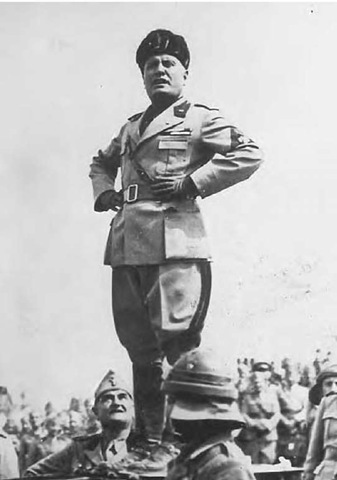The Italian Fascist leader, Mussolini was born near Forli in northeastern Italy. His father, a blacksmith, was an active Socialist and Mussolini’s early forays in the field of propaganda were also left-wing. In 1913 he became editor of the Socialist newspaper Avanti! (Forward!).World War I saw his dramatic conversion to nationalism, with Mussolini supporting Italy’s entry into the war on the Allied side. In 1914 he founded his own daily paper, Popolo d’Italia (People of Italy), to advance this cause. Beginning in 1915, he drew a substantial subsidy from the French government’s propaganda budget. After a period of war service, Mussolini resumed his editorship of the newspaper in 1917. The latter became a key platform from which he organized his Fasci di Com-battimento (Fascist Party) in 1919.
Mussolini’s rise to power rested on nationalistic propaganda, a personality cult, and a willingness to engage in street violence. Mussolini utilized many tools of paramilitary propaganda, including uniforms (the Black Shirt), flags, and parades to create a sense of belonging among his followers. He borrowed much from the earlier nationalistic performances of playwright Gabriele D’Annunzio (1863-1938), including frenzied balcony speeches and the straight-arm “Roman” salute. Mussolini’s first major success came in 1921 when he and thirty-four other Fascists were elected to the Chamber of Deputies. In 1922 he used the tactic of a massive “March on Rome” to force the king to name him prime minister. Mussolini swiftly consolidated his control of the media. His international propaganda efforts included a famous series of articles (1927-1934) for the Hearst newspaper chain in the United States.
Benito Mussolini, in a characteristic braggadocio pose.
Mussolini placed himself at the center of his regime’s propaganda, with slogans proclaiming that “Mussolini is always right.” He stage-managed rallies and speeches; ensured a flattering appearance in the papers and news-reels by adopting athletic or energetic poses; and supported everything from larger families to increased levels of agricultural production. Mussolini’s drive to project his regime as the successor to the Roman Empire brought forth grandiose public works and even overseas military adventures, such as the conquest of Abyssinia in 1935-1936, which resulted in the expulsion of Italy from the League of Nations. As an international pariah, Mussolini grew closer to his onetime imitator Adolf Hitler (1889-1945), with whom he concluded the Axis pact of 1936 and the “Pact of Steel” in 1939. He joined Hitler’s war against the European democracies in 1940, but in July 1943, with the Allies landing on the Italian mainland, found himself out of office through the simple expedient of having been sacked by the king. After being rescued by German paratroops, Mussolini ruled a puppet Italian National Socialist Republic (Salo) in northern Italy. In April 1945 he was captured, tried, and executed by partisans. In death this inveterate propagandist himself became an icon; his body was exhibited up-side down, the traditional fate of traitors during the Renaissance in the Florentine republic.

